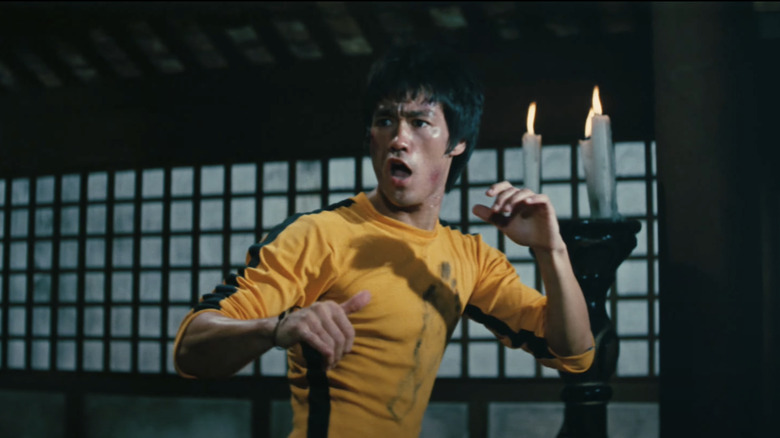Did Bruce Lee’s Final Movie Really Use A Shot Of His Corpse?
The legend surrounding Bruce Lee and his impact on cinema simply can’t be understated. Though he was born in the United States, Lee spent much of his early days in Hong Kong, perfecting his skills in martial arts. With his foot in both countries, Lee became a cross-cultural icon, popularizing and legitimizing martial arts films in the west. A global superstar, Lee’s towering career came to a short end when he died in 1973 at just 32 years old. Controversy still haunts Lee’s death, but his passing has also been emboldened on the silver screen. The 1978 film “Game of Death,” released five years after his passing, features footage of Lee’s funeral, showing his body in an open casket.
While the decision to show Lee’s corpse was (and still is) perceived to be in poor taste, director Robert Clouse’s reasoning is interesting. “Game of Death” first went into production in 1972, with Lee both starring in and directing the picture. He had shot around 100 minutes of footage for the film, before putting production on pause to headline what would become his martial arts masterpiece, “Enter the Dragon.” Unfortunately, Lee died shortly before “Enter the Dragon” was released, leaving “Game of Death” incomplete.
Clouse, who directed “Enter the Dragon,” was then tasked with bringing “Game of Death” back to life. With his lead star gone and only a decent amount of footage available, Clouse retooled the narrative of “Game of Death” in a drastic way. One key decision made was to feature Lee’s corpse — a creative choice that changed the film forever.
What Bruce Lee’s Game of Death was supposed to be about
When Bruce Lee was tinkering with “Game of Death,” he obviously didn’t intend for his corpse to be in the final product. Circumstances forced director Robert Clouse to completely shift “Game of Death,” removing almost all of Lee’s philosophical ideas, save for key action sequences. The Hong Kong icon’s original version featured Lee as a retired martial arts champion whose life is turned upside down after his siblings are kidnapped by gangsters. In a bid to save them, Lee’s hero recruits other fighters to join him as he goes through five different levels of a pagoda (a multi-tier tower), each of which has a unique enemy. At the top of the tower is a specific relic that the protagonist needs to acquire.
Stylistic and filled with ruminative ideas about martial arts, the final version of the film helmed by Clouse barely resembles this. With Lee gone, the filmmaker pivoted the narrative into a revenge film. In that version, Lee stars as Billy Lo, a famous martial artist who is at odds with the mafia. The character fakes his death (which is where footage of Lee’s funeral and his corpse comes from) and sets out to destroy the villains.
The released version of “Game of Death” only features 11 minutes of the footage Lee originally filmed and reuses certain scenes from his previous films. While the final product obviously wasn’t what the martial artist wanted audiences to see, it does boast some of Lee’s most epic fight scenes ever.



